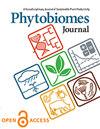Leaf endophyte community composition and network structures differ between tolerant and susceptible English boxwood
IF 2.6
3区 生物学
Q2 MICROBIOLOGY
引用次数: 0
Abstract
Differential tolerance of English boxwood to boxwood blight has been linked to the ratio of culturable bacterial and fungal dominance in the leaf tissue of representative samples. To further understand how the whole endophyte communities may involve the tolerance of large samples, we extracted DNA from healthy leaf tissue of previously identified 28 tolerant (T), 41 moderately tolerant (M) and 21 susceptible (S) English boxwood plants, then sequenced associated bacterial and fungal amplicons using the Nanopore MinION platform. The endophyte community did not differ in diversity among the T, M, and S plants, but differed in the abundance of bacteria and fungi, particularly between T and S samples. The bacterial genera Brevundimonas and Ammonifex had higher relative abundance in the T and M communities than in the S community which was more dominant by the fungal genera Botrytis, Thermothelomyces and Chaetomiaceae. The same results were obtained when mother and daughter samples in the T community were compared with controls in the S community, suggesting bacteria as a work force in the T community. Co-occurrence network analyses revealed that the T network had more fungal hubs but less complex with more positive connections than the S network, suggesting that the T community was supported by a healthier network. The resistance of English boxwood to blight is likely attributed to bacteria dominance and a synergic community network. This study is foundational to constructing synthetic communities and using whole communities of tolerant plants through vegetative propagation for microbe-modulated immunity.耐受性和易感性英国黄杨叶片内生菌群落组成和网络结构的差异
英国黄杨对黄杨枯萎病的不同耐受性与代表性样品叶组织中可培养细菌和真菌优势的比例有关。为了进一步了解整个内生菌群落如何涉及大样本的耐受性,我们从先前鉴定的28种耐受性(T)、41种中度耐受性(M)和21种易感性(S)英国黄杨植物的健康叶组织中提取DNA,然后使用Nanopore Mineion平台对相关的细菌和真菌扩增子进行测序。内生菌群落在T、M和S植物之间的多样性没有差异,但细菌和真菌的丰度不同,特别是在T和S样品之间。Brevundimonas属和Ammonifex属在T和M群落中的相对丰度高于S群落,后者以真菌属Botrytis、Thermothellomyces和Chaetomiaceae更为优势。当将T群落中的母亲和女儿样本与S群落中的对照组进行比较时,也获得了相同的结果,这表明细菌是T群落的劳动力。共现网络分析显示,与S网络相比,T网络具有更多的真菌枢纽,但不那么复杂,具有更多的正连接,这表明T社区得到了更健康的网络的支持。英国黄杨对枯萎病的抗性可能归因于细菌优势和协同群落网络。这项研究是构建合成群落和通过营养繁殖利用整个耐受植物群落获得微生物调节免疫的基础。
本文章由计算机程序翻译,如有差异,请以英文原文为准。
求助全文
约1分钟内获得全文
求助全文

 求助内容:
求助内容: 应助结果提醒方式:
应助结果提醒方式:


